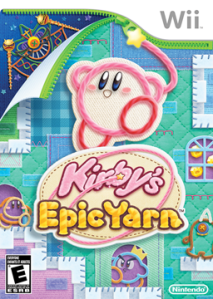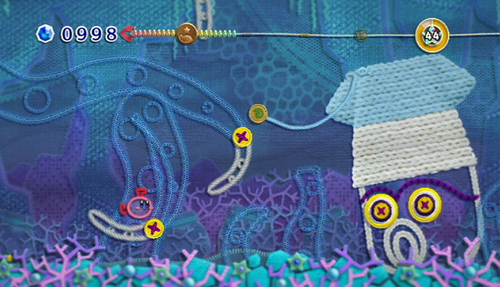Kirby’s Epic Yarn – Review
Developers: Feel-Good and Hal Laboratories
Publisher: Nintendo
Director: Kentaro Sei
Platform: Nintendo Wii
Perhaps “epic” is not the adjective I would use to describe Kirby’s new patchwork tale. “Clever” is the first thing that comes to mind, though I suppose “Kirby’s Clever Yarn” does not quite have the same impact. Kirby’s Epic Yarn is, despite being another puzzley side-scrolling platformer starring our inflatable pink friend, is innovative enough to avoid being just another Kirby game.
Epic Yarn‘s textile aesthetic is the first thing anyone will notice. It is, frankly beautiful, with anything and everything being made of stitched-down cloth, loose thread, yarn, buttons, zippers, anything one might find on their clothes. It is colorful and bright and does it without being gaudy, which is a nice break from all the brown and grey “realism” so popular these days. Of course, the idea of a textile-themed platformer brings Little Big Planet to mind, but playing the game I never once found myself comparing the two. Kirby is much brighter and more animated looking. Instead of having the world look like an actual construction of random objects and cloth, Kirby does not try to look at all realistic. It looks more like, well, a game. Also unlike Little Big Planet, Kirby’‘s textile look is not just a look—it is the whole game. Instead of Kirby’s trademark inhale-eat-transform trick, he tosses out a loose piece of his own yarn body and winds his yarn foes up with it. Instead of transforming for powers he can transform at will by warping his outline into things like a small car, a parachute, and submarine, among other things. He can even unwind himself to fit through narrow crevasses.
It’s not just Kirby, either—the levels also embrace the cloth theme. Instead of filling levels with swarms of enemies to avoid, the world is filled with little platforming puzzles based around unwinding things, swinging from buttons, undoing zippers, pulling loose thread, you get the picture. Of course, being a Kirby game there are still transformation puzzles like drifting on air currents as a parachute, but they are the clear minority and even they rely on yarn transformations. As mentioned before, the fabric visual style is more than just the graphics and visuals, they are the entire game. It is great integration of graphics and gameplay, which is for some reason absent in too many titles. There is not much in the way of plot, but even that is all about the game’s theme. An evil yarn-made wizard is turning everything into yarn and cloth, and at the end of each level Kirby is awarded a piece of magic yarn that is literally the thread that holds the fabric of the world together. The cinematics are little more than an excuse to make sewing puns, though Kirby games have never exactly been plot-heavy, so we can excuse that. It does not really even need it to push you along—I was interested enough in just seeing what the next level would look like, for throughout the game there is not a single stage theme that gets repeated. Every level is noticeably unique, which another thing done right on the design front.
Though the sewing motif lends the game its unique feel, the lack of real challenge strips the mechanics of their depth. There is literally nothing standing between the player and success. You cannot lose in Kirby’s Epic Yarn. Once you start a level, the only way to fail is to give up, and this is unlikely considering they are not all that difficult to get through. The only penalty for “taking damage” or falling in a hole is loss of beads, which are collected throughout the level for a grade of either nothing, bronze, silver, or gold. It is almost instinctive to aim for a gold even knowing there is no punishment for not getting it, but even that is not too difficult, for whenever beads are lost they can be reclaimed again unless they fall into a hole or disappear after about thirty seconds. The removal of lives is interesting and a little appreciated, but without a way to fail they might as well stay. If levels could be failed based on score, so only gold or silver medals would advance, Yarn would be a much better game—still pretty easy, but at least there would be incentive beyond that which the player creates. Kirby has always been aimed at younger audiences, who I am sure find no objection to an easier difficulty, but it will ruin the game for most players.
The no-fail aspect of Kirby’s Epic Yarn is reminiscent of many art games, actually, where players are practically carted through to see everything in between. It makes me think a little of Limbo, since in both Kirby and Limbo the player is pushed to the right, stopped almost exclusively by puzzles (seeing as you have no health to lose in Kirby, enemies are usually little more than puzzles or the answers to puzzles themselves) and advancing by solving them.
There is also a two-player mode, much like a few older Kirby titles, wherein player two plays as the scowling, blue, crowned Prince Fluff, who shares Kirby’s shape and yarn powers. There were segments within the game that I was glad to have a partner to get or give a boost to where I could not easily find a way onto a platform with some beads or a collectible on it. On the other hand, there were some parts, usually more platform-ey bits, where we would find ourselves trying to be in the same place at the same time so as not to drag the camera behind and make advancing difficult for whoever decided to go first, which almost always ended with both players falling to their doom. It is much better than, say,New Super Mario Bros. Wii where you can footstool each other and have no real way of aiding one another at all. Players can pick each other up, but it is easy to escape and this mechanic proved to be quite helpful after we had beaten all of the enemies in an area and only after the fact found that we needed a projectile to break a certain type of block. The players can also stand on each other without interfering with each other, allowing two players to double their total jump distance. Players can also teleport to their partner at will, which allows for some useful cooperation.
Overall, Kirby’s Epic Yarn is a charming game. It is not great—it leaves no lasting impression, it does not take much effort to get through it, and it won’t last all that long, but it is cute and pretty and I would not go so far as to call it a bad game. It is a game for Kirby fans, or a nice pick-me-up, or an easy transition for new gamers, but not something I would recommend to most players.
Posted on December 21, 2010, in Reviews and tagged Kirby's Epic Yarn, Nintendo, Review. Bookmark the permalink. Leave a comment.



Leave a comment
Comments 0